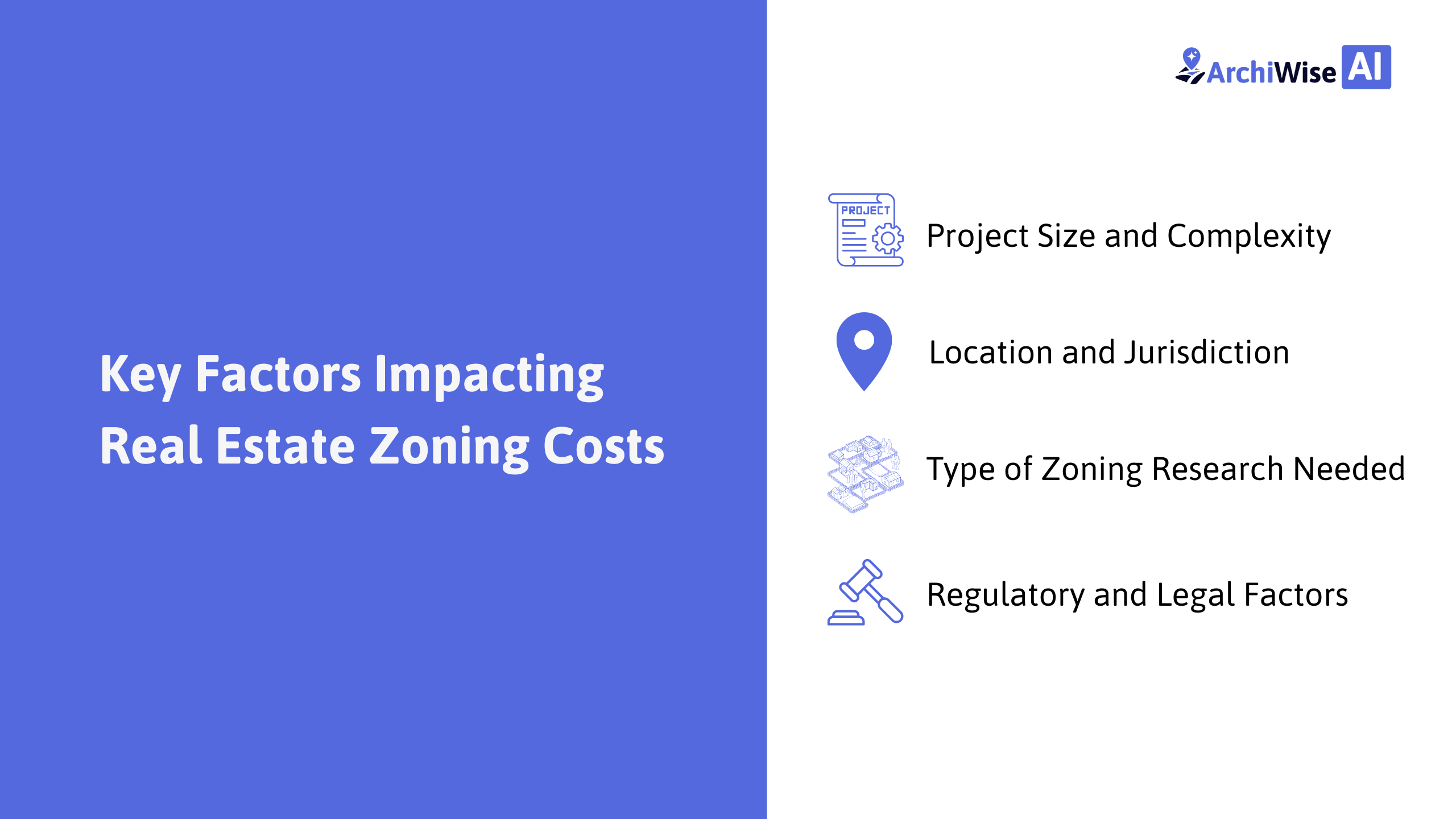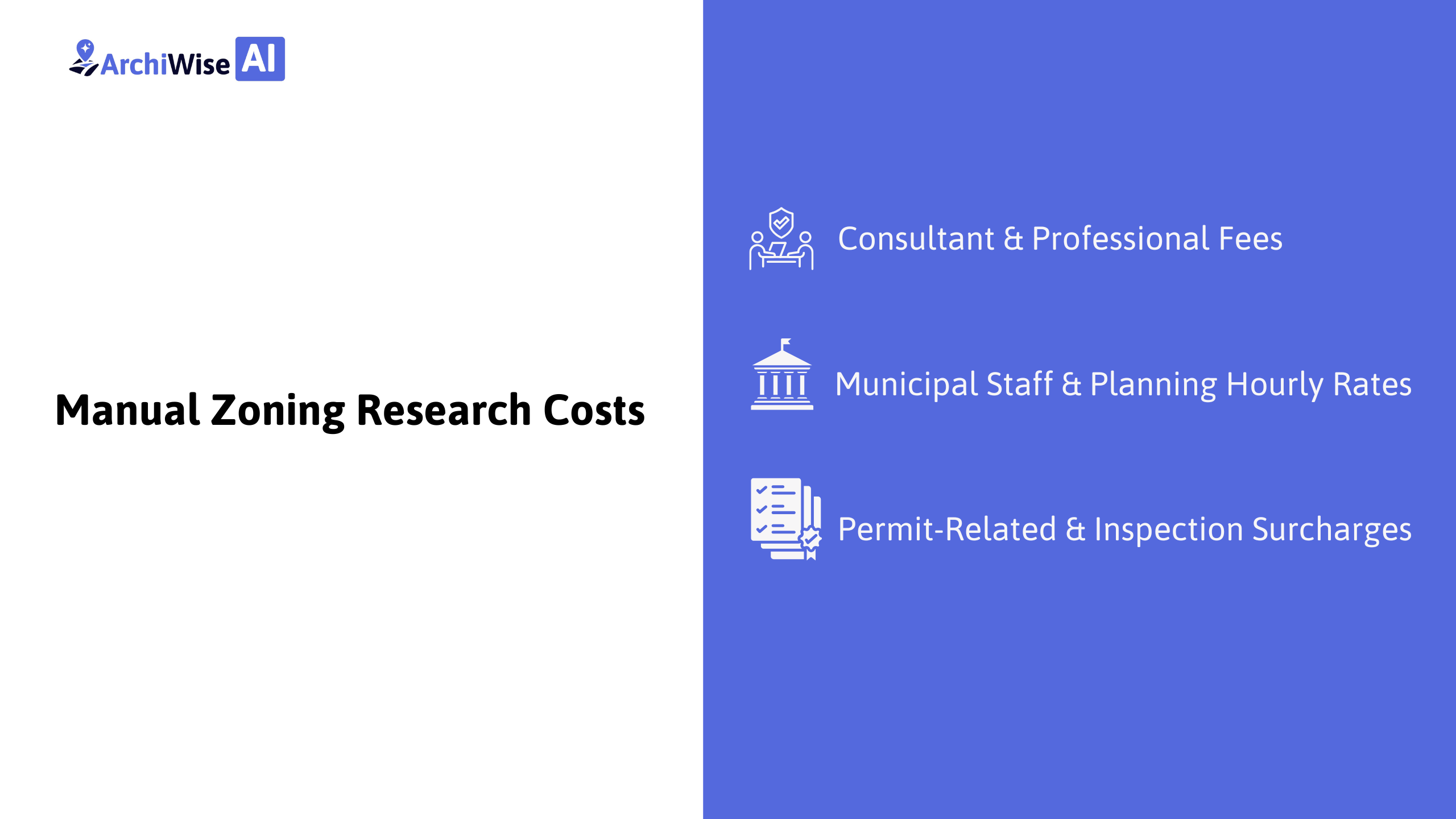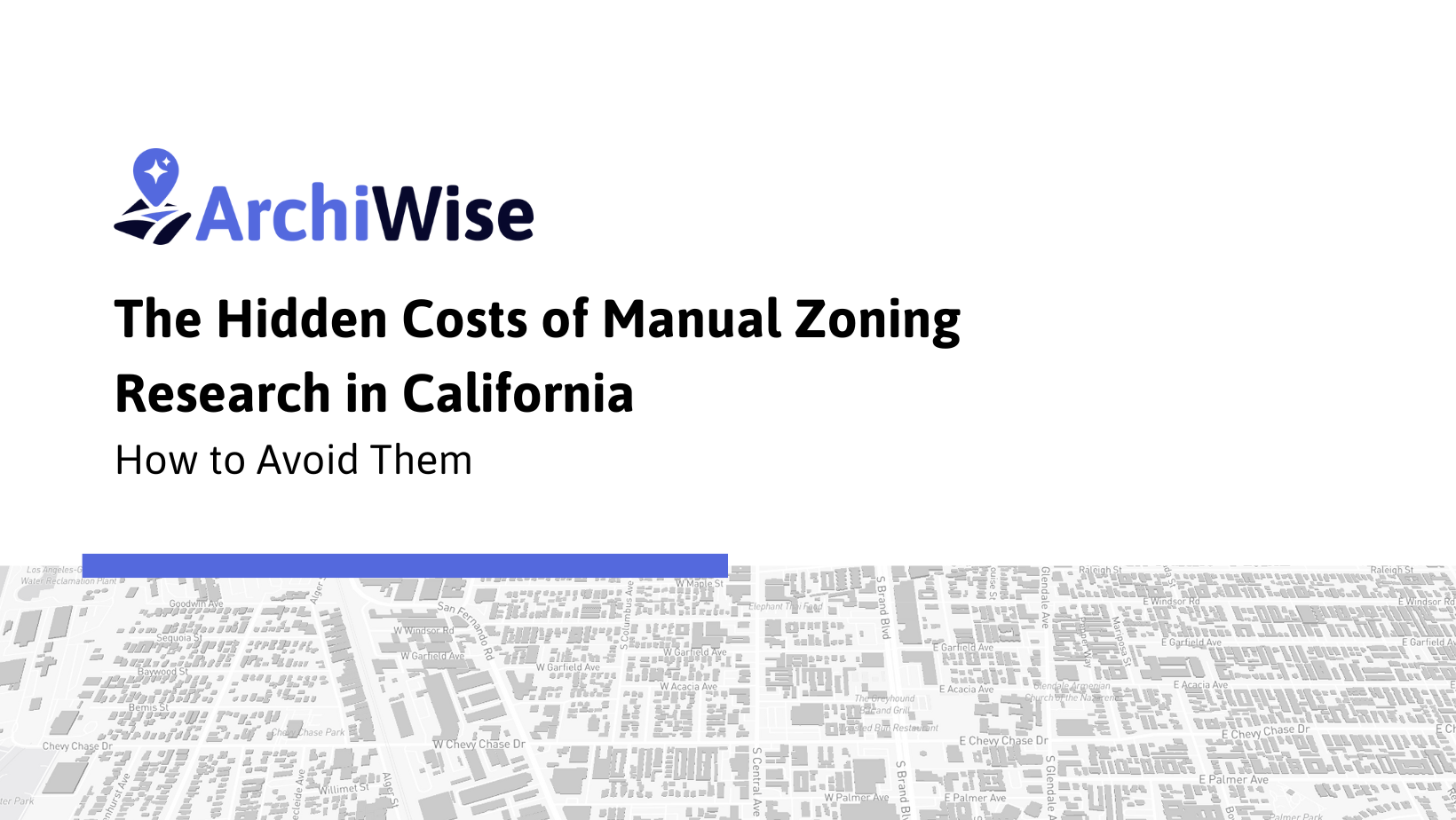Manual zoning research requires a significant amount of time and money and is prone to errors. This article explores the hidden financial, operational, and opportunity expenses linked to manual processes and how AI-driven solutions such as ArchiWise drastically improve pre-development processes.
Introduction:
Real estate’s one of the most valuable assets in the U.S., but honestly, getting anything done means playing by a ton of rules. Zoning laws tell you what’s allowed where, and building codes dictate how it has to be built. Managing all that manually? It’s a drain
- on your time,
- your revenue, and
- your team’s sanity, for sure.
Each hour dedicated to manual zoning analysis raises your research expenses, heightens operational risks, and can delay projects from the outset.
Let's face it — we all know the struggle.
Wasting countless hours on complicated zoning research, tracking regulations across multiple sources, yet delays and unexpected costs always pop up. In California, besides the manual work, zoning research alone can cost up to $315 per hour. Add to that employee time, consultant fees, and potential compliance risks, and the numbers quickly add up.
The good news is that AI is here to help, and that’s where Archiwise AI comes in. By automating zoning research and providing accurate, up-to-date, city-specific insights, our platform drastically cuts research time, reduces errors, and let’s developers, architects, and real estate experts to make smarter, faster decisions. The result? You save money, time, and with fewer surprises in your pre-development processes.
Key Factors That Impact Real Estate Zoning Costs
Before diving into the financial side of a manual zoning study, it’s important to understand what really drives up zoning expenses. These costs come from a combination of factors: professionals involved in manual processes, the time spent navigating complex local regulations, and the resources required to ensure compliance. Each of these elements—time, money, and effort—directly affects the overall price tag of zoning work.
1. Project Size and Complexity
As your development increases in size or complexity, zoning review gets a lot more demanding. Projects like multifamily housing, mixed-use buildings, or anything spanning several zoning districts? Those will need more staff hours, extra consultants, and a longer wait for municipal review. Especially in California, you’re looking at dozens of hours spent on research and back-and-forth, which can translate to thousands of dollars just for zoning research alone.
2. Location and Jurisdiction
Zoning costs really depend on where you’re working. In major cities like Los Angeles, San Francisco, or San Diego, fees tend to be higher and the regulations are much stricter. Smaller towns? Usually less expensive, with fewer hurdles. Each city or county has its own specific rules, permits, and fee schedules, so developers need to stay on top of these differences to navigate the process smoothly.
3. Type of Zoning Research Needed
Of course, depending on the project, the requirements may differ. But in general, as a real estate develope,r you should consider the following
- Basic Zoning Verification – figuring out what uses are allowed and what the zoning designation is.
- Feasibility Studies – a more in-depth look at limits on density, restrictions, and the potential for development.
- Conditional Use or Variance Research – finding special approvals or exceptions, which can take a lot longer.
4. Hidden Regulatory and Legal Factors
Beyond direct fees, zoning costs are affected by:
- Compliance risks – mistakes can lead to major fines, redesigning your entire pre-development projects, or stop-work orders at all.
- Environmental or historical overlays – special districts or protected city areas often add complexity to the project and require additional, unique research.
- Delays in municipal review – bureaucratic bottlenecks can drastically extend timelines, increasing opportunity costs and bringing additional expenses because of extended reviews.

Before diving into the actual financial and operational impact of manual zoning research, it's important to get a clear picture of the main factors at play. Honestly, these are the reasons why costs can swing so much—and why errors or hold-ups can get extremely expensive, fast.
Key Takeaways
- The size and complexity of the project directly affect the time and expense of zoning research.
- Location and jurisdiction are important; stricter cities and urban areas tend to be more expensive.
- Effort is determined by the type of research: conditional use/variance analysis, feasibility studies, and basic verification.
- While hiring a consultant saves time, there are major costs involved ($20k to $100k+ in California).
- Overlays, compliance concerns, and municipal delays are examples of hidden regulatory elements that can significantly raise expenses and schedules.
The True Costs of Manual Zoning Research
Zoning approvals are a significant line item expense in any development budget, not merely a formality. Knowing the direct expenses of zoning research is essential for California real estate investors, developers, and architects in order to create correct pro formas and prevent overruns.
Consultant & Professional Fees
Many teams turn to land-use or zoning consultants to handle complex rules and complicated data, manage applications, and represent them at hearings.
- Depending on the project's size and whether environmental or historic overlay concerns come up, zoning consultant fees in California often range from $20,000 to over $100,000.
- For entitlements or variances, expert legal counsel may cost an additional $5,000 to $25,000 or more.
The costs of consultants and attorneys alone can account for 5–10% of the pre-development budget in the majority of mid-size projects.
Municipal Staff & Planning Hourly Rates
When it comes to municipal planning or zoning processes in California, be prepared for significant hourly staff charges.
- For example, Ventura County currently sets its planning division contract rate at $195.81 per hour for planner services.
- Hemet takes a similar approach, charging $214 per hour for planning division work not explicitly listed in its fixed fee schedules.
- Paso Robles matches that rate for planning work, while engineering services in the same city are billed at $230 per hour.
In short, whenever your application or project requires staff time, those are the rates you can expect—if not higher. It’s a clear reflection of direct municipal staff costs, and it’s something applicants should factor into their budgeting from the outset.
Permit-Related & Inspection Surcharges
Before you even receive your building permit, several fees tend to pop up on the invoice. Municipalities rarely miss an opportunity to tack on extra costs, so here’s what you’re likely to see:
- Zoning clearance or plan-check fees typically run anywhere from $1,000 to $5,000 for standard projects. It’s the price of admission just to have your plans reviewed.
- Environmental or historical overlay reviews can add another $3,000 to $15,000+ to your budget, depending on the site’s characteristics and the level of consultant review required.
- Then, traffic and infrastructure impact assessments come into play. These fees range from $5,000 up to $20,000, depending on the project’s scale and the local jurisdiction’s requirements.
All these surcharges can add up quickly—often well before any actual construction has even begun. It’s crucial to factor these costs into your project budget right from the start.
What This Means for Your Budget
Once you start piling up those consultant retainers, city review fees, plan-check surcharges, and all the paid staff hours, the direct costs of zoning research for a mid-sized California development can get out of hand fast. It’s not unusual to see these expenses hit the tens of thousands—or even push past six figures—before anyone so much as breaks ground. Honestly, overlooking these upfront costs is one of the most common reasons pro-formas tank when it’s time to secure financing.
Key Take-Aways

-
Zoning consultant fees and municipal review charges—those are the big-ticket items you can actually see coming.
-
Planning departments bill by the hour, anywhere from $150 to $500, so if your application needs multiple passes, costs can pile up quickly.
-
Researching zoning requirements alone can eat up 5–15% of your pre-development budget, especially for more complex projects.
The smart move? Lay out these costs in detail from the start. That way, developers and architects can plan for contingencies and get a clear read on ROI before things get too far along.
What Can Go Wrong: Key Compliance Risks
Here’s the reality when it comes to zoning and compliance—small mistakes can have big consequences.
- Permit Rejection or Incomplete Applications
If your application is missing key documents—like site plans, signed forms, or current surveys—expect delays or outright rejection. It’s a common problem. Misunderstanding zoning details, such as setback requirements or floor area ratio, is another surefire way to get your project denied. Even experienced teams trip up here if they’re not careful.
- Multiple Revision Cycles
Don’t expect a single submission to cut it. Most jurisdictions will require several rounds of revisions if your plans don’t fully align with local codes. Every revision means more waiting, more staff input, and extra fees. For example, Sacramento County distinguishes between major and minor revisions, while other areas like Riverside routinely send plans back for correction. Depending on how complex the issues are, you could be looking at a quick turnaround—or weeks of back-and-forth.
- Legal & Regulatory Challenges
Misinterpreting zoning regulations or comprehensive plan requirements can easily land your project in legal trouble. Legal risks also include referenda that can overturn zoning amendments, or lawsuits over whether zoning laws are being applied consistently. It’s a challenging environment—legal review is essential before moving forward.
Bottom line: thorough preparation and attention to detail are critical for avoiding setbacks and costly delays in the permitting process.
The Cost of Getting It Wrong
- Repeated fees & staff time: Every revision requires plan check fees, additional staff hours, and often consultant involvement. These costs accumulate.
- Opportunity cost: Delays from permit rejections or revision cycles postpone project commencement, delaying revenue or increasing holding costs (for land, financing, insurance).
- Legal costs and risk: If a project moves ahead without proper zoning compliance, you might face cease-work orders, penalties, or be required to make costly modifications. Even worse, legal challenges or referenda can stop or reverse project approvals.
How AI Avoids the Hidden Costs of Zoning Research
Let’s face it—traditional zoning research can be a huge drain on resources. Before you even get close to construction, you’re sinking cash into consultants, drowning in paperwork, and waiting on permits. All that time and those delays? They quietly chip away at your margins and push projects off schedule.
That’s where AI zoning platforms like Archiwise make a real impact. Instead of weeks lost to manual digging, you get fast, clear answers. Fewer bottlenecks, less wasted money, and a real reduction in risk.
Key takeaway:
AI zoning tools streamline the entire pre-development process. You save time, control costs, minimize errors, and give your ROI a serious boost.
Cut Research Time by 70–90%
-
Traditional zoning research? It’s slow—painfully slow. Teams spend weeks, sometimes months, poring over municipal codes, zoning maps, overlays, and the latest amendments, especially in California. But with AI-driven zoning analysis, you’re cutting that timeline down to hours, sometimes even minutes. You get instant access to the details you need, so your site selection and due diligence move at the speed your business demands.
-
Time saved here isn't just a nice-to-have—it's money in your pocket. Shorter research cycles mean lower holding costs on interest, taxes, and insurance. You can push projects forward faster, right into permitting and construction, and that means a better ROI.
Consultant & Administrative Costs
-
Traditional zoning consultants in California don’t come cheap. Hourly rates routinely range from $150 to $350, and all-in, you might drop $2,500 to $15,000+ per site. For what? Answers you can now get internally, thanks to AI.
-
Bring zoning feasibility in-house. With the right tools, your team can cover up to 80% of the preliminary research without leaning on consultants for every question. Bring in the experts only when the legalese gets tricky or you need a final sign-off.
The result? You’re saving thousands on each parcel—funds that can be redirected straight into development, acquisition, or design. It’s a smarter, faster, and far more cost-effective way to handle zoning.
Reduce Compliance Errors and Streamline Revision Cycles
- AI zoning platforms now automatically check for key compliance factors—setbacks, density, FAR, parking, overlays, and environmental constraints—across your projects. This automation significantly cuts down on zoning mistakes and the risk of permit rejection or those dreaded, expensive plan revisions.
- Fewer errors mean faster approvals, less time wasted going back and forth with city planning departments, and reduced legal exposure overall.
Centralize and Standardize Data Across Jurisdictions
- Zoning rules in the U.S. are notoriously fragmented, with over 39,000 municipalities and only about 30% of codes accessible in centralized databases like eCode360.
- AI zoning solutions such as Archiwise aggregate and interpret these scattered sources, providing developers and architects with a single, searchable platform for multi-site analysis. This centralization enables better, faster decision-making on a regional and national scale for real estate and development firms.
Unlock Faster, Smarter Site Selection
- Let's be real—finding the right parcel doesn't have to be a shot in the dark anymore. With AI, you get instant side-by-side comparisons: zoning compliance, development potential, restrictions, and all the details that matter.
- Skip the tedious manual steps. Automated zoning feasibility studies highlight your most profitable options early in the process, cutting down opportunity costs and keeping you way ahead of anyone still stuck in old-school workflows. Get the insights you need, make sharper decisions, and leave your competition behind.
Key Takeaway:
AI zoning software isn’t just a productivity upgrade—it’s a smart way to sidestep unnecessary costs. For developers, architects, and real estate pros, these AI zoning feasibility tools can:
- Speed up pre-development timelines
- Cut down on consultant fees and holding costs
- Lower legal and compliance risks
- Boost ROI by getting projects to market faster
Practical Implementation: Reducing Manual Zoning Costs with AI
Step-by-Step Checklist:
- Centralize municipal codes, and city specific maps into one AI platform
- Enter your project’s location, type, and target density
- Run automated zoning scans to pull up constraints and regulations
- Instantly generate feasibility and ROI reports for multiple sites
- Use AI plan checkers to review compliance before submitting plans
- Refine your approach based on AI insights from previous projects
In short, leveraging AI zoning solutions means you're working smarter, not harder—saving time, money, and reducing risk, all while keeping your project pipeline moving. The fact is that AI software in real estate is getting bigger and better, and the only right thing to do is to be a part of this change.
FAQ Section
Q1: How much time does AI actually save on zoning research?
A: Honestly, it’s a game changer. Tasks that used to take weeks—sometimes even longer—now get done in minutes, even for those tricky, complicated projects. It’s a serious efficiency boost.
Q2: Does AI replace planners or consultants?
A: Not at all. AI takes care of the time-consuming stuff like pulling data and running compliance checks, so planners and consultants can zero in on strategy and the approvals process. It’s about making their jobs smarter, not replacing them.
Q3: Can AI analyze multiple cities or jurisdictions at once?
A: Absolutely. AI can scan thousands of municipal codes across different regions, all at the same time. Whether your projects are local or spread out, it keeps up.
Q4: How does AI improve return on investment in pre-development?
A: It helps you compare sites faster, uncovers regulatory opportunities you might’ve missed, and cuts down on expensive last-minute revisions. At the end of the day, it means you access better sites sooner and move through approvals with fewer headaches.
Conclusion: Future-Proof Your Pre-Development with Archiwise
In today’s fast-paced market, manually digging through zoning regulations just isn’t practical—especially when your ROI is on the line. Archiwise steps up with AI-powered zoning analysis, automated compliance checks, and predictive insights that streamline your workflow. For developers, architects, and real estate teams, that means cutting research time by more than 90%, reducing back-and-forth revisions, and spotting profitable opportunities much faster.
Don’t let old-school processes drag your projects down. Book a free demo today, or just try Archiwise for yourself for FREE—see firsthand how AI can reshape your pre-development process.
